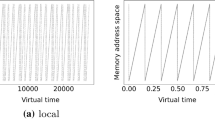Summary
Commonly used memory management strategies in a paged environment optimize separately the page-fault rate (by proper choice of a replacement algorithm) and the response time of the paging drum (by a shortest-access-time-first discipline with multiple sectors). In this paper we consider replacement strategies which attempt to maximize useful CPU utilisation and hence throughput by choosing the page to be replaced on the basis of its probability of reference as well as on the rapidity with which the page can be removed from main memory, assuming that a fixed-head disk or drum is used as a secondary memory. An analysis of the approach is given using a mathematical model. Analytical results for the gain in CPU utilisation are obtained under mono-programming and numerical examples are presented illustrating the effects of variation of program behaviour and of variants of the replacement strategy.
Similar content being viewed by others
Explore related subjects
Discover the latest articles and news from researchers in related subjects, suggested using machine learning.Références
Mémoires auxiliaires à disques magnétiques DIAD. CII manuel C 90097 9B
Aho, A. V., Denning, P., Ullman, J. D.: Principles of optimal page replacement. J. ACM 18, 80–93 (1971)
Weingarten, A.: The Eschenbach drum scheme. Comm. ACM 9, 509–512 (1966)
Coffman, E. G., Jr.: Analysis of a drum input/output queue under scheduled operation in a paged computer system. J. ACM 16, 73–90 (1969)
Gelenbe, E.: A unified approach to the evaluation of a class of remplacement algorithms. IEEE Trans. Computers 22, 611–618 (1973)
King III, W. F.: Analysis of demand paging algorithms. Proc. IFIP Congr. 71. Amsterdam: North-Holland 1972, p. 485–490
Vantilborgh, H.: On random partially pre-loaded page replacement algorithms. MBLE, Bruxelles, Report R 202 (1972)
Author information
Authors and Affiliations
Rights and permissions
About this article
Cite this article
Gelenbe, E., Lenfant, J. & Potier, D. Analyse d'un algorithme de gestion simultanée mémoire centrale — disque de pagination. Acta Informatica 3, 321–345 (1974). https://doi.org/10.1007/BF00263587
Received:
Issue Date:
DOI: https://doi.org/10.1007/BF00263587




